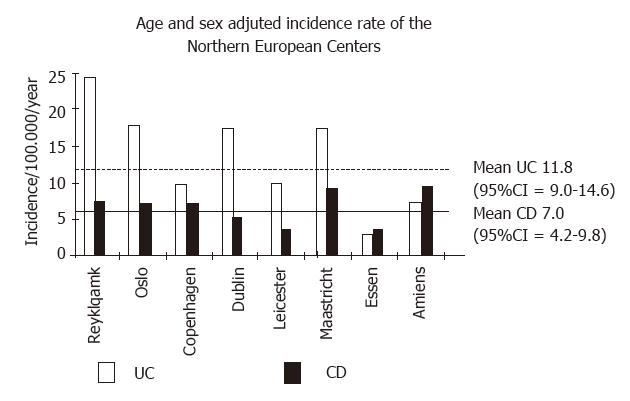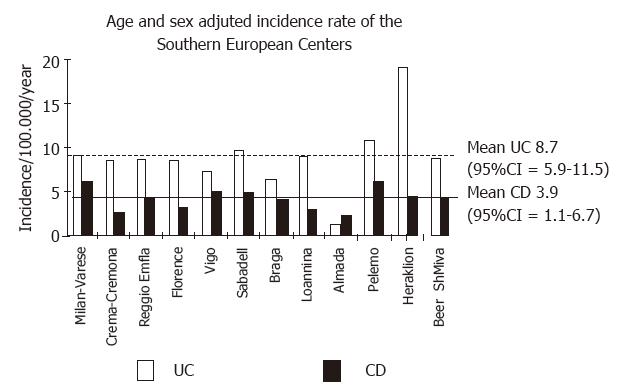Published online Oct 15, 1998. doi: 10.3748/wjg.v4.iSuppl2.22
Revised: August 18, 1998
Accepted: September 12, 1998
Published online: October 15, 1998
- Citation: Shivananda S. Epidemiology and disease outcome in inflammatory bowel disease: observations from the European Collaborative Study. World J Gastroenterol 1998; 4(Suppl2): 22-23
- URL: https://www.wjgnet.com/1007-9327/full/v4/iSuppl2/22.htm
- DOI: https://dx.doi.org/10.3748/wjg.v4.iSuppl2.22
Epidemiology is concerned with the study of distribution and determinants of dis ease in the population. It can be also applied to study the course and prognosis of disease over time.
Ulcerative colitis (UC) and Crohn’s disease (CD) are chronic, inflammatory diseases of the gut. They are more prevalent in the urban-industrial societies of America and Europe than in the populations of Africa, China or India. Environmental factors, lifestyle(diet, smoking, oral contraceptives) and genetic susceptibility are being investigated as possible causal factors in disease on set/or as determinants of disease behaviour and disease outcome.
Over the years it has been suggested that the incidence of IBD is three or more times higher in northern than in southern Europe. The aim of the ECIBD study was to investigate the hypothesis of north-south gradient in a prospective epidemiological survey of disease incidence between 1991-1994. The study group consisted of investigators from 20 centres across Europe ranging from Iceland, Copenhagen and Oslo in the north to Heraklion and Palermo in the south. In the middle were centres from the Iberian peninsula, Britain, France, Germany, Ireland, and the Netherlands, All participants designated a defined geographic area for the study and used uniform criteria of case definition, a common protocol for recording epidemiological and diagnostic data and obtained a “near” complete ascertainment of incident cases, in the respective defined areas, at the symptomatic stage of disease onset. All centres had high quality endoscopy, high quality radiology, and a well trained pathologist to establish proper diagnosis and separate case from non-case in UC,CD and indeterminate colitis.
It was through this process an inception cohort of 2201 patients were identified, of whom 1379 (63%) had UC, 706 (32%) had CD, and 116 (5%) were indeterminate. The overall incidence per 100000 of the population was 10.4 for UC and that of CD was 5.6. The age and sex-adjusted rates of UC in the populations of northern Europe was 11.8 and in the south it was 8.7. In CD the age and sex- adjusted rate was 7.0 in the north and 3.9 in the south. Disease distribution, by participating centre, in the north and south of Europe is shown in Figures 1 and 2.
An analysis of the diagnostic methods used, anatomical site, and extent of disease showed little overall difference between centres in the north and south of Europe. Likewise, analysis of the presenting symptoms such as bowel frequency, occurrence of rectal bleeding, weight loss, and abdominal pain suggested no systematic differences in severity of symptoms at presentation between cases in the northern and southern Europe[1,2].
In conclusion, this study suggested a modest excess of incidence of IBD in north ern Europe. The magnitude of the observed excess for both conditions was less than expected on the basis of the previous studies. This may reflect recent increases in the incidence of IBD in southern Europe whereas those in the north may have stabilised. The aetiology of these conditions is unclear and it is therefore difficult to explain the pattern found. That similar north-south gradients in incidence have also been documented in the United States suggests that several factors may be involved, including climate, diet, economic wealth and development, or genetic susceptibility. The collaborative network established under the EC-IBD study provides a framework for conducting such studies in low incidence areas such as China, and to examine putative environmental factors involved in disease causation.
Follow-up data on disease outcome in 595 (27%) of the original cohort of 2201 patients with IBD was available for review in 1997. 394 (66%) of the patients in follow-up had UC(40% male); and 201 (34%) had CD (52% male). The follow-up data came from 7 of the 20 original centres participating in the EC-IBD study. They obtained a complete follow-up of more than 95% of their patients and the mean follow-up period was 46 mo (nearly foura). The investigators completed a standard follow-up form containing questions on vital status, physician’s global assessment of disease activity and treatment. The status of 32% of these patients was checked by personal interview, 31% through telephone, 28% from hospital record and contact with medical specialists, and 9% from other sources.
At 1996-1997 follow-up 9 patients had died, 2 of them with causes related to IBD (toxic colitis and complications of UC). Physician’s assessment of disease activity showed that a large proportion (81%) of the cohort had clear symptomatic improvement and only few (9%) had no change or worsening of symptoms (Table 1).
| UC | CD | Total | |
| Symptom free | 176 (45) | 62 (31) | 238 (40) |
| Improvement | 151 (38) | 94 (47) | 245 (41) |
| No change | 22 (6) | 16 (8) | 38 (6) |
| Worse | 9 (2) | 10 (5) | 19 (3) |
| Unknown | 36 (9) | 19(9) | 55 (9) |
In UC 68% had drug treatment at the time of follow-up, 96% of these used SA SP or 5-ASA. In CD 73% had treatment, of which 80% used SASP or 5-ASA. The remaining patients in both conditions were treated with corticosteroids or immunosuppressives, with a higher proportion receiving this treatment in CD (Table 2).
| UC (%) | CD (%) | |
| 5-ASA or SASP | 65 | 67 |
| Corticosteroids | 13 | 26 |
| Immunosuppressives | 3 | 11 |
| None | 33 | 19 |
Assessment of disease outcome in a large inception cohort of patients with IBD showed that the majority had symptomatic improvement over a four year period after diagnosis and mortality from IBD relat ed causes was low. In Europe, with present medical treatment, medium-term outcome of IBD appears favourable[3].
E- Editor: Li RF
| 1. | Shivananda S, Lennard-Jones J, Logan R, Fear N, Price A, Carpenter L, van Blankenstein M. Incidence of inflammatory bowel disease across Europe: is there a difference between north and south Results of the European Collaborative Study on Inflammatory Bowel Disease (EC-IBD). Gut. 1996;39:690-697. [RCA] [PubMed] [DOI] [Full Text] [Cited by in Crossref: 684] [Cited by in RCA: 665] [Article Influence: 22.9] [Reference Citation Analysis (0)] |
| 2. | Lennard-Jones JE, Shivananda S. Clinical uniformity of inflammatory bowel disease a presentation and during the first year of disease in the north and south of Europe. EC-IBD Study Group. Eur J Gastroenterol Hepatol. 1997;9:353-359. [RCA] [PubMed] [DOI] [Full Text] [Cited by in Crossref: 81] [Cited by in RCA: 77] [Article Influence: 2.8] [Reference Citation Analysis (0)] |










